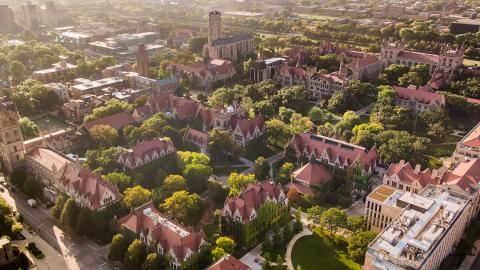In India, stories are more than just oral narratives; they are events, complete with song and dance. "Performed dances are an important part of the narrative," explained Wendy Doniger, the University of Chicago's Mircea Eliade Distinguished Service Professor in the Divinity School.
As part of the "India Blooms in Chicago Festival," Chicagoans will have a chance to experience the Indian narrative dance tradition firsthand on Saturday, April 26, 2008 , from 3 to 5 p.m. at the International House at University of Chicago, 1414 E 59th St.
Dancers Rumya P. Chatterjee, Shipra Mehrotra, and Kiran Chouhan will showcase the intricate footwork, gesture, and athleticism of Indian narrative dance in “Stories in Motion: Narrative Dance in India,”
The event is free and open to the public, and will be preceded by an introduction by Doniger, one of the world’s leading scholars of Hinduism and South Asian mythology, on the history of the Indian narrative tradition.
Several distinct regional traditions will be performed during the two-hour presentation, including:
Kathak, performed by Kiran Chouhan, which derives its name from “Katha,” the art of storytelling. Originally, this North Indian dance form was performed in Hindu temples for the worship of God. But the form has evolved, and has emerged into a new dance form with the body movement, hand gestures and facial expression depicting Hindu philosophy and the intricate rhythmic pattern and footwork of Persian arts.
Odissi, performed by Shipra Avantica Mehrotra, is one of the seven classical dance forms of India. Like most of the other classical styles, Odissi originated as an expression of spirituality, a means to connect with a supreme being through a state of yogic harmony and bliss. It is distinguished from the other classical dance styles by its sculpturesque beauty and graceful fluidity.
Kuchipudi, from the south of India, is named after the village of its origin. It’s a unique form that utilizes styles from the Karnatic, South Indian classical tradition). Aesthetically, however, Kuchipudi is a far more athletic dance form – it was only practiced by men until the 20th century -- and places a greater emphasis on fluid lines.
“Stories in Motion: Narrative Dance in India,” is just a part of the “India Blooms in Chicago” festival. To celebrate the performance of John Adams’s newest operatic masterpiece “A Flowering Tree,” which is based on an Indian folk tale translated by the A.K. Ramanujan, a faculty member at the University for more than 30 years, the Chicago Opera Theater has organized a month long festival highlighting India’s rich and vibrant culture and the art of storytelling across genres. During the festival, Indian music, dance, and women’s stories will be performed, and scholars will discuss the history and context of the Indian storytelling tradition.
Upcoming events include “Stories Told: Through the Voices of South Indian Women,” in which Doniger will discuss the folktale that inspired John Adams opera, and “Stories Heard: Musical Narratives of India,” in which University of Chicago ethnomusicologist Kaley Mason will discuss the integral role that music plays in telling stories – from classical Indian music styles to Bollywood films.
For a complete list of all the “India Blooms in Chicago” events, visit: http://www.chicagooperatheater.org/education/ibic.html










